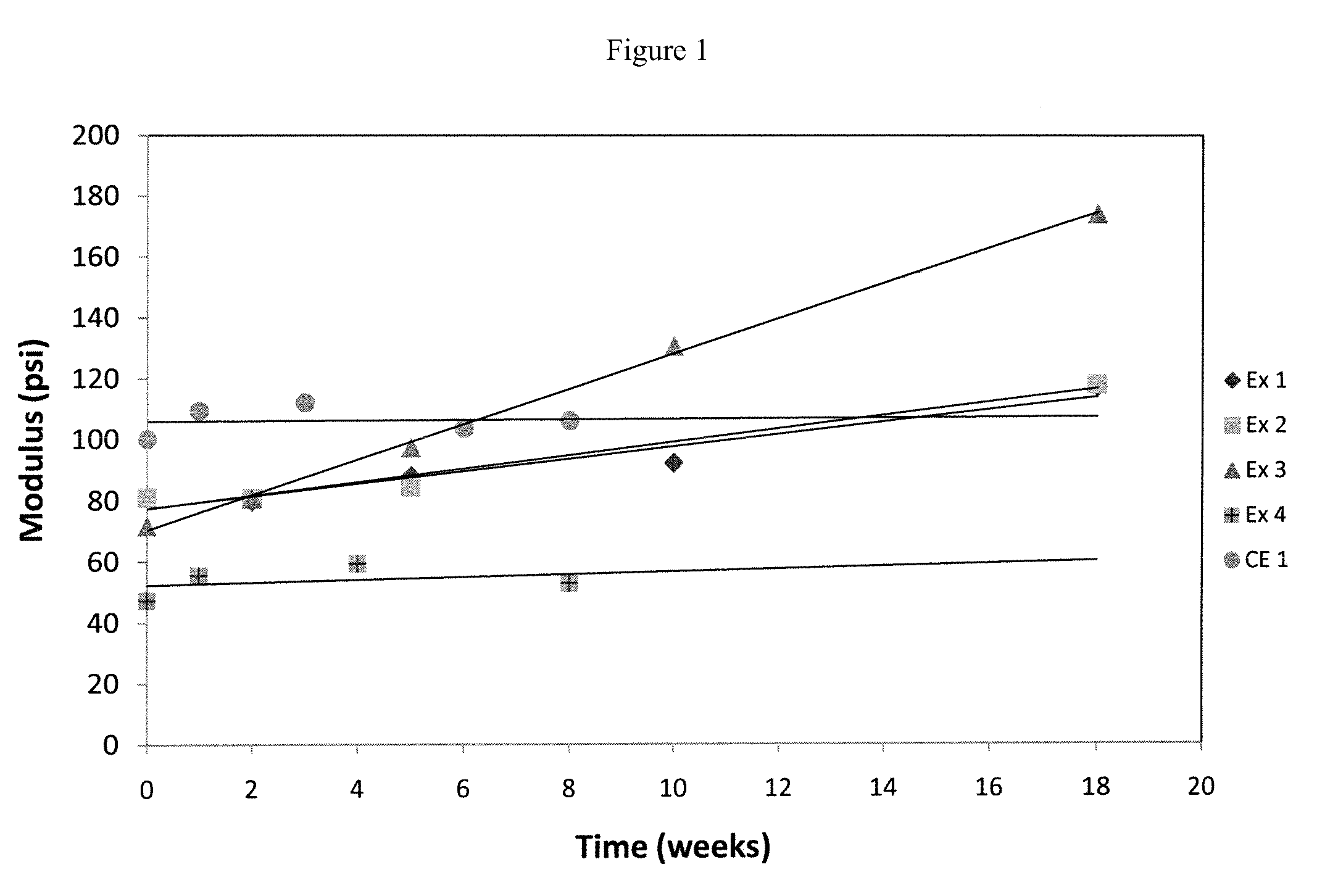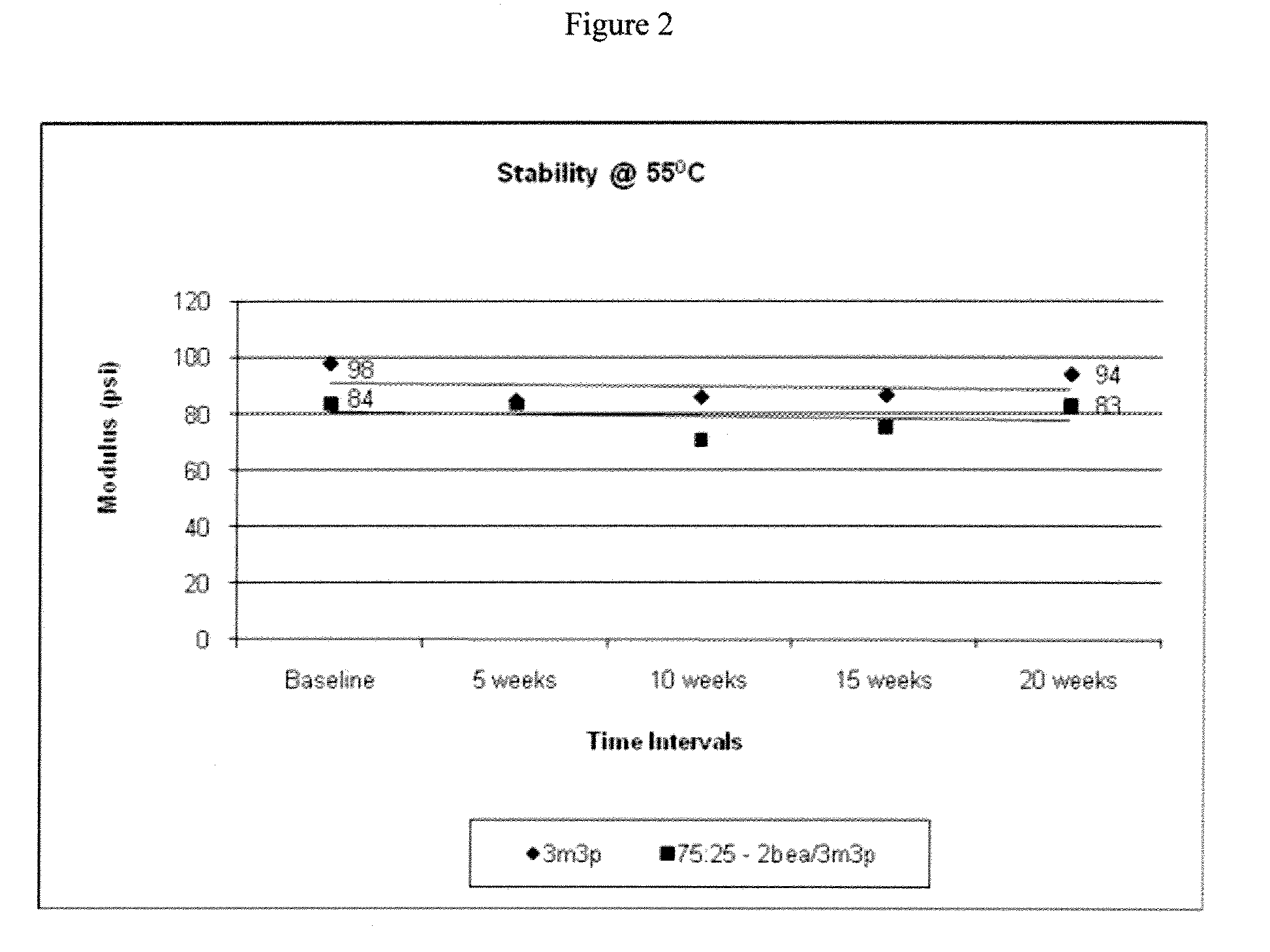Ionic silicone hydrogels having improved hydrolytic stability
a technology of ionic silicone and hydrogel, which is applied in the field of ophthalmic devices, can solve the problems of inability to hydrolyze contact lenses, increased display moduli, and high cost, and achieves the effects of improving thermal stability, facilitating protein uptake, and improving thermal stability
- Summary
- Abstract
- Description
- Claims
- Application Information
AI Technical Summary
Benefits of technology
Problems solved by technology
Method used
Image
Examples
examples
[0106]The following abbreviations are used in the examples below:[0107]Macromer Macromer prepared according to the procedure disclosed under Macromer Preparation in Example 1, of US-2003-0052424-A1[0108]acPDMS bis-3-acryloxy-2-hydroxypropyloxypropyl polydimethylsiloxane (MW 2000, acrylated polydimethylsiloxane) from Degussa[0109]Blue HEMA the reaction product of Reactive Blue 4 and HEMA, as described in Example 4 of U.S. Pat. No. 5,944,853[0110]CGI 819 bis(2,4,6-trimethylbenzoyl)-phenylphosphineoxide[0111]CGI 1850 1:1 (wgt) blend of 1-hydroxycyclohexyl phenyl ketone and bis(2,6-dimethoxybenzoyl)-2,4-4-trimethylpentyl phosphine oxide[0112]D3O 3,7-dimethyl-3-octanol[0113]DMA N,N-dimethylacrylamide[0114]EGDMA ethyleneglycol dimethacrylate[0115]HEMA 2-hydroxyethyl methacrylate[0116]MAA methacrylic acid[0117]mPDMS monomethacryloxypropyl terminated mono-n-butyl terminated polydimethylsiloxane, manufactured by Gelest, molecular weight specified in the Examples[0118]Norbloc 2-(2′-hydroxy-5-...
examples 1-3
[0126]Lenses having the formulations shown in Table 1 were made as follows. The diluent for Examples 1-3 was a mixture of 18.33 gm PVP 2500 / 48.34 gm t-amyl alcohol. The diluent for Example 4 was 16.2 gm PVP 2500 / 64.8 gm t-amyl alcohol. The monomer mixes were dispensed into Zeonor front and Zeonor:Polypropylene (55:45) back curves. The monomer mixtures were cured under visible light (Philips TL-03 bulbs) in a nitrogen atmosphere (about 3% O2) using the following cure profile: 1 mW / cm2 for about 20 seconds at ambient temperature, 1.8±0.5 mW / cm2 for about 270 seconds at 75±5° C., and 6.0±0.5 mW / cm2 for about 270 seconds at about 75±5° C.
[0127]After curing, the molds were opened, and the lenses released in 70% IPA in DI water. After about 40-50 minutes the lenses were transferred into: i) 70% IPA in DI water for about 40-50 minutes; ii) 70% IPA in DI water for about 40-50 minutes; and iii) DI water for at least about 30 minutes.
[0128]The lenses were packaged in 950+ / −50 uL of borate buf...
example 4
[0129]Lenses were made using the formulation listed in Table 1, for Example 4, and the conditions described in Example 1, except that the cure profile was: 1 mW / cm2 (10-30 seconds, ambient temperature), 1.5±0.2 mW / cm2 (about 160 seconds, at 80±5° C.), 6.0±0.2 mW / cm2 (about 320 seconds, at about 80±5° C.)].
[0130]The molds were opened, and the lenses released in 70% IPA in DI water. After 60 minutes the lenses were transferred into: i) 100% IPA for 60 minutes; ii) 70% IPA in DI water for 60 minutes; iii) DI water for 30 minutes; iv) DI water for 30 minutes; v) DI water for 30 minutes.
[0131]The lenses were silver-treated by exposure to aqueous sodium iodide solution, followed by exposure to aqueous silver nitrate solution. The lenses were packaged in 10 mL of SSPS in glass vials with silicone stoppers, and autoclaved three times (121° C., 30 minutes).
[0132]Stability Evaluation
[0133]Lenses from Examples 1-4 and Comparative Example 1 were placed in a chamber with temperature controlled a...
PUM
| Property | Measurement | Unit |
|---|---|---|
| weight % | aaaaa | aaaaa |
| water content | aaaaa | aaaaa |
| contact angle | aaaaa | aaaaa |
Abstract
Description
Claims
Application Information
 Login to View More
Login to View More - R&D
- Intellectual Property
- Life Sciences
- Materials
- Tech Scout
- Unparalleled Data Quality
- Higher Quality Content
- 60% Fewer Hallucinations
Browse by: Latest US Patents, China's latest patents, Technical Efficacy Thesaurus, Application Domain, Technology Topic, Popular Technical Reports.
© 2025 PatSnap. All rights reserved.Legal|Privacy policy|Modern Slavery Act Transparency Statement|Sitemap|About US| Contact US: help@patsnap.com



